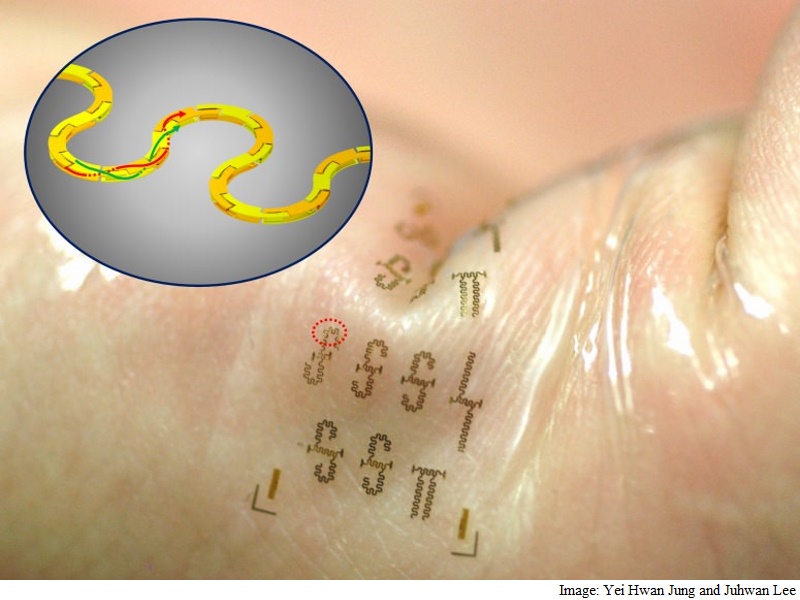- Home
- Wearables
- Wearables News
- New Wearable Circuits Could Revolutionise Internet of Things
New Wearable Circuits Could Revolutionise Internet of Things

Led by Zhenqiang "Jack" Ma from University of Wisconsin-Madison, the team developed the new stretchable integrated circuits taking inspiration from twisted-pair telephone cables. They contain, essentially, two ultra-tiny intertwining power transmission lines in repeating S-curves.
This serpentine shape - formed in two layers with segmented metal blocks, like a 3D puzzle - gives the transmission lines the ability to stretch without affecting their performance, said the study, published recently in the journal Advanced Functional Materials.
It also helps shield the lines from outside interference and, at the same time, confine the electromagnetic waves flowing through them, almost completely eliminating current loss. The stretchable integrated circuits can operate at radio frequency levels up to 40 gigahertz.
Unlike other stretchable transmission lines, whose widths can approach 640 micrometres, the new stretchable integrated circuits are just 25 micrometres thick. That's tiny enough to be highly effective in epidermal electronic systems, among many other applications.
"We've found a way to integrate high-frequency active transistors into a useful circuit that can be wireless," said Ma.
The technology can serve as a platform for manufacturers seeking to expand the capabilities and applications of wearable electronics - particularly as they strive to develop devices that take advantage of a new generation of wireless broadband technologies referred to as 5G.
The new integrated circuits could be used in wearable electronics that adhere to the skin like temporary tattoos. Because the circuits increase wireless speed, these systems could allow health care staff to monitor patients remotely, without the use of cables and cords.
Catch the latest from the Consumer Electronics Show on Gadgets 360, at our CES 2026 hub.
Related Stories
- Samsung Galaxy Unpacked 2025
- ChatGPT
- Redmi Note 14 Pro+
- iPhone 16
- Apple Vision Pro
- Oneplus 12
- OnePlus Nord CE 3 Lite 5G
- iPhone 13
- Xiaomi 14 Pro
- Oppo Find N3
- Tecno Spark Go (2023)
- Realme V30
- Best Phones Under 25000
- Samsung Galaxy S24 Series
- Cryptocurrency
- iQoo 12
- Samsung Galaxy S24 Ultra
- Giottus
- Samsung Galaxy Z Flip 5
- Apple 'Scary Fast'
- Housefull 5
- GoPro Hero 12 Black Review
- Invincible Season 2
- JioGlass
- HD Ready TV
- Laptop Under 50000
- Smartwatch Under 10000
- Latest Mobile Phones
- Compare Phones
- OPPO Reno 15 Pro Max
- Honor Win RT
- Honor Win
- Xiaomi 17 Ultra Leica Edition
- Xiaomi 17 Ultra
- Huawei Nova 15
- Huawei Nova 15 Pro
- Huawei Nova 15 Ultra
- Asus ProArt P16
- MacBook Pro 14-inch (M5, 2025)
- OPPO Pad Air 5
- Huawei MatePad 11.5 (2026)
- Xiaomi Watch 5
- Huawei Watch 10th Anniversary Edition
- Acerpure Nitro Z Series 100-inch QLED TV
- Samsung 43 Inch LED Ultra HD (4K) Smart TV (UA43UE81AFULXL)
- Asus ROG Ally
- Nintendo Switch Lite
- Haier 1.6 Ton 5 Star Inverter Split AC (HSU19G-MZAID5BN-INV)
- Haier 1.6 Ton 5 Star Inverter Split AC (HSU19G-MZAIM5BN-INV)

















